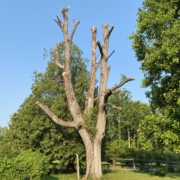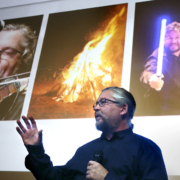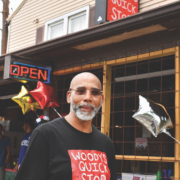Old Tree Saved As Wildlife Habitat
By Doug Pifer
For the past five years, every time it stormed we worried that a big limb would break off our beloved old Kentucky coffee tree and destroy our entryway fence. Now our property is safe from that disaster, and a magnificent old tree remains as wildlife habitat.
I invited Erik Berndt, certified arborist and owner of Viking Tree Service, LLC, to inspect the nearly dead tree. My wife and I wanted to save as many main branches as possible while minimizing the risk of damage by falling wood. He agreed our tree was an excellent candidate for trimming as a wildlife habitat tree. He encouraged me to look at some of the standing dead trees at Morgan’s Grove Park, which his company cares for, to see examples of his work. We were impressed when we examined several standing dead trees there. Each was trimmed to look like a natural dead snag in the woods. After years of cringing whenever we saw a big shade tree with branches crudely lopped off, we were overjoyed to find a company willing to trim our tree the way we wanted. We were also delighted to find a tree service that considers a wildlife habitat tree an actual “thing.”
The Viking Tree crew showed up at the appointed time with an impressive array of equipment and machinery. With block and tackle they ascended the main trunk and carefully removed the outer branches. When they encountered a heavy limb whose weight would stress the tree in a storm, they removed it with surgical precision. But they didn’t stop there. They made a series of V-shaped cuts at the top of each large limb to allow moisture to enter the dead wood, so the tree decays from the top down. This allows the main trunk to remain sound and stand for many years. Furthermore, cuts carefully made at various angles made the limbs look like they splintered and broke off naturally.
For hard-to-reach limbs, a large lift was necessary. Each cut made the tree look safer and less likely to drop a branch to crush our fence or garden shed.
By 4pm the crew had completed the finishing touches, and I admired the balanced, sculptural quality of the tree and its remaining branches. It was a piece of art.
While it’s now official, this tree had already been wildlife habitat for a long time. Several trunks have woodpecker holes in them. The lowest branch sprouts a tuft of stunted Kentucky coffee tree leaves. Years ago, a bird dropped a seed of bush honeysuckle into the crotch between two main trunks about ten feet up. The seed has grown into a sizeable bush. More bits of green include poison ivy and Virginia creeper vines, and a young Kentucky coffee tree shoot that has sprouted next to the trunk, growing from the original
root system.
A tree is home to an amazing amount of life. As it matures and declines, it hosts an increasing number of organisms — from mold and bacteria to algae and fungi, to insects and spiders to woodpeckers and raccoons. Fallen limbs continue to feed and shelter numerous life forms as they decompose and enrich the soil.
For an old tree, dying isn’t an occurrence but more of a gradual transformation. Our Kentucky coffee tree demonstrates how a treasured old tree need not be destroyed. It can stand for many years as wildlife habitat.



